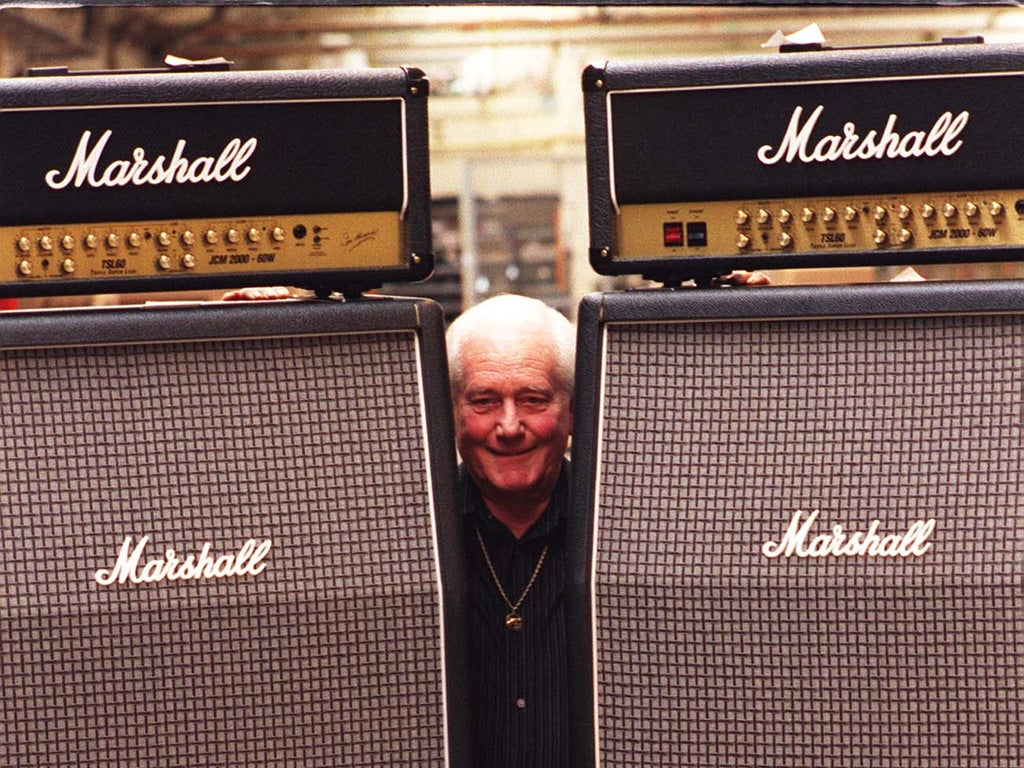Jim Marshall: Guitar amp pioneer who earned the epithet 'Father of Loud'

In the mid-1960s, the emergence of the powerful Marshall amplifiers enabled musicians to turn up the volume – and effectively transformed pop music into rock.
Marshall became the amplifiers of choice for guitarists as diverse and influential as Jeff Beck, Ritchie Blackmore, Jimi Hendrix, Johnny Ramone and The Who's Pete Townshend, whose demands for a louder, more harmonically rich sound contributed to the genesis of the 100-watt model and the 4 x 12 stacks that became de rigueur for rock bands like Status Quo, AC/DC and Van Halen.
Though he founded the company, Jim Marshall always acknowledged the input the engineers Ken Bran and Dudley Craven had into the range of equipment that bore his name. "We went all out to build a lead amp," he said. "I made the chassis, while Ken and Dudley designed and built the circuitry. I had chats with Pete Townshend and the session guitarist Big Jim Sullivan. The amplifiers at the time veered more towards jazz or country and western... the guitarists wanted something thicker. Fender was too clean. Listening to what they said imparted in my mind the idea of the Marshall sound. I always call it dirty, but it's really a harmonic distortion."
Built to last and to withstand repeated attacks by Hendrix and Townshend – "they only tore the baffling cloth," stressed Marshall – eulogized in song by Motörhead, and famously lampooned and turned up to 11 in the mockumentary This Is Spinal Tap, Marshall Amplification became one of Britain's most successful music companies.
Born in West London in 1923, Jim Marshall didn't have the easiest start. He was diagnosed with tuberculosis of the bones and spent years in and out of the Royal National Orthopaedic Hospital in Stanmore, to which he made charitable contributions in later life. By the age of 14, he had given up on formal education and passed on the opportunity to work alongside his father in the family's fish and chip shop.
His illness meant that he failed his army medical, but he spent the Second World War working at Ceramic Engineering, and then was a toolmaker at Heston Aircraft. He also started a parallel career as featured singer and then drummer with a big band. "I was making 10 shillings a night," he recalled. "I would ride my bicycle with a trailer behind it to carry my drumkit and the public address cabinets which I had made."
In order to approximate the flamboyant playing style of his idol, the jazz band leader Gene Krupa, he started taking drum lessons and became proficient enough to teach the next generation of London drummers, including Mitch Mitchell, who went on to join the Jimi Hendrix Experience. "I used to teach about 65 pupils a week and, what with playing as well, I was earning somewhere in the region of £5000 a year. That's how I first saved enough money to go into business," said the enterprising Marshall, who opened a music store in Hanwell, West London.
Soon, he was not only selling drumkits, but also building bass cabinets. "The bass guitarists used to complain that they were being out-gunned all the time by the lead guitar... I had the idea of using two 12" speakers with the 50 watt amp head, but it didn't give us the sound we wanted... We kept blowing the speakers," explained Marshall, who had been joined by Bran and Dudley in 1962.
They developed various prototypes and eventually hit on the right combination at the sixth attempt. "We had the idea of putting four 12" speakers into the smallest enclosure we could. There was nothing brilliant about designing the first 4 x 12, it was purely the most convenient size to get into the transport that groups had in those days," he admitted. "I thought that it didn't look very nice with just the amp sitting on top, so I did the angle to match the dimensions of the amplifier and make it look a neater package."
This model proved so popular that by 1964, Marshall had opened his first factory in Hayes. The following year, he signed a distribution agreement with Rose Morris, the instrument suppliers that put Marshall in every major music retailer around the world. Marshall, Bran and Dudley also made the first 100 watt amp for Townshend, who felt he was losing the amplification battle to Who drummer Keith Moon and bassist John Entwistle.
The ensuing escalation in feedback and volume earned Marshall the nickname the Father of Loud, especially following the emergence of Hendrix, whose middle name happened to be Marshall. "He was our greatest ambassador," said Marshall.
In 1985, Marshall was invited to add his handprints to the Rock Walk Hall of Fame in Hollywood alongside the instrument pioneers Leo Fender, Robert Moog, Les Paul and Bill Ludwig. He was appointed OBE for his services to music and charity in 2003.
Equipment and instrument manufacturers can be secretive about their products, but Marshall was always happy to show visitors around his factory in Milton Keynes. Asked if his amps had damaged people's hearing, he would reply that those claims were "over-exaggerated. I've met all the top guitarists and they never say: 'Pardon? What did you say?' They always hear what I say."
James Charles Marshall, amplifier manufacturer: born London 29 July 1923; twice married (one son from first marriage, one daughter, one stepson, one stepdaughter from second marriage); died Milton Keynes 5 April 2012.
Join our commenting forum
Join thought-provoking conversations, follow other Independent readers and see their replies
Comments